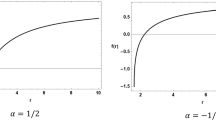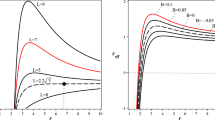Abstract
In this study, we explicitly prove that the null circular orbit outside the spherically symmetric asymptotically flat hairy black hole is not stable. Although, if there is more than one external light ring at least one of them is stable. The existence of such geodesics has been proved in the recent work of Hod as well as Peng whereas its stability was left uncommented.
Similar content being viewed by others
Avoid common mistakes on your manuscript.
1 Introduction
Black holes are the solution of Einstein’s field equations. Although theoretically, their existence has been known from the early times of Einstein’s theory of gravity, their direct observation is not possible as their strong gravity doesn’t even allow the light to escape. Therefore, the indirect effects of the black holes, such as the photon sphere/light rings which are the circular geodesics of the null particle outside the horizon becomes very important [1,2,3,4,5,6,7,8,9,10,11,12,13,14,15,16,17,18,19,20]. In [21], it is proved that in a d-dimensional static, asymptotically flat, spherically symmetric black hole spacetime with the line element
where \(d\Omega _{d-2}^{2}\) is the line element on the unit sphere \(S^{d-2},\) there exist circular null geodesics outside the black holes that are unstable. The well-known Schwarzschild and Reissner–Nordström black holes are included in (1). More recently in [22] Hod studied the existence of light rings in extremal black hole spacetime. In the context of the static asymptotically flat spherically symmetric black holes, Hod analytically proved that non-extremal black holes admit at least one external light ring. The same fact had also been proven before [22] in [23, 24]. Furthermore, in accordance with [22], the existence of the external light rings in an extremal black hole is not guaranteed by the non-linearly coupled Einstein-matter field equations [22]. Following this ambiguity about the extremal black holes, Hod in a very recent work [25] has proven that spherically symmetric asymptotically flat extremal hairy black hole supported by an external matter field that satisfies the dominant energy conditions admit at least one external closed null geodesics. Moreover, in another very recent study Peng in [26] has also proven analytically that such a light ring exists for the extremal spherically symmetric asymptotically flat hairy black holes. Unlike [25], Peng in [26] employed the fact that null circular geodesics outside black holes are the fastest orbital trajectory with the smallest period. This fact has been proved also by Hod in [27].
Inspired by all the mentioned works, in particular [25,26,27], in this Letter, we prove analytically that the light rings outside the static asymptotically flat spherically symmetric black holes are not stable.
2 The circular geodesics and their instability
Following [26] we start with the hairy, static, spherically symmetric asymptotically flat line element
in which \(\delta \left( r\right) \) and \(\mu \left( r\right) \) are the metric functions. The line element (2) describes some kind of hairy black hole such that at the event horizon \(\mu \left( r_{H}\right) =0\) and \(\delta \left( r_{H}\right) <\infty .\) Moreover, for the line element to be asymptotically flat, we impose \(\mu \left( r\rightarrow \infty \right) \rightarrow 1\) and \(\delta \left( r\rightarrow \infty \right) \rightarrow 0\), and both metric functions are well-defined and finite in the interval \( r\in \left( r_{H},\infty \right) .\) Let us add also that for the black hole to be extremal, one should impose an additional condition implying \(\mu ^{\prime }\left( r_{H}\right) =0\). Referring to [26], to prove the existence of the null circular geodesic we may not apply this additional condition. In [26] the main concern was to prove that in the bulk spacetime (2) and outside the black hole there exists at least one circular orbit irrespective of the line element (2) be an extremal black hole or non-extremal. Here we review the proof given in [26], briefly. The Lagrangian of a null particle moving in the vicinity of the black hole (2) on the equatorial plane with \(\theta =\frac{\pi }{2}\) is given by
in which a dot stands for the derivative with respect to an affine parameter. The conserved quantities of the geodesic motion are the energy and the angular momentum which are found to be
and
respectively. Furthermore, for a null particle one imposes \(\dot{x}_{\alpha } \dot{x}^{\alpha }=0\) which after (4) and (5), it implies
in which
Equation (6) suggests that for a circular orbit where \(r=r_{c},\) we should impose \(\dot{r}^{2}=0\) which implies \(V_{eff}\left( r_{c}\right) =0.\) Furthermore, to have free-force motion one should also impose \(\left. \frac{d }{dr}V_{eff}\left( r\right) \right| _{r_{c}}=0.\) Applying the first condition i.e., \(V_{eff}\left( r_{c}\right) =0\) one finds
The effective potential (7) yields
which upon considering (8) at \(r=r_{c}\) it simplifies
The latter is the main condition to be satisfied in order to prove the existence of the circular geodesics for \(r_{c}>r_{H}.\) To show that (10 ) is satisfied, Peng in [26] used the fact that the circular orbits are the orbits with the shortest period. This fact was shown by Hod in [27]. For a null particle, the period of a circular orbit on the equatorial plane is simply given by considering \(\bigtriangleup s=\bigtriangleup r=\bigtriangleup \theta =0\) and \(\bigtriangleup \phi =2\pi \) and consequently \(\bigtriangleup t=\left. 2\pi \sqrt{\frac{r^{2}}{e^{-2\delta \left( r\right) }\mu \left( r\right) }}\right| _{r_{c}}\) or simply
is the period of any circular orbit of radius \(r_{c}.\) Now, to minimize the period we apply
which yields
The latter equation admits at least one solution for \(r_{c}\) because the period (11) in the two extremes i.e., \(r_{c}\rightarrow r_{H}\) and \( r_{c}\rightarrow \infty \) goes to infinity implying that it takes at least one minimum value in between the two extremes. Furthermore, the solution(s) of (13) satisfies the main condition (10) as well which completes the proof of the existence of the circular orbit.
From hereafter, we continue the analysis of the Ref. [26] and prove that such a circular orbit is not stable. To do so we recall that having \( \left. \frac{d}{dr}V_{eff}\left( r\right) \right| _{r_{c}}=0\) grantees the existence of the circular orbit, however, in order for the orbit to be stable one has to impose \(\left. \frac{d^{2}}{dr^{2}}V_{eff}\left( r\right) \right| _{r_{c}}>0.\) From (9), we calculate explicitly
such that at \(r=r_{c}\) where (8) and (10) are already held, it becomes
Next, to reveal the sign of \(\left. \frac{d^{2}}{dr^{2}}V_{eff}\left( r\right) \right| _{r_{c}}\), once more we return to the shortest period orbit theory of Hod [27]. Referring to Eq. (13), in order for the possible solution of (13) to correspond to the minimum period, one has to impose further the following condition
at \(r_{c}\) satisfying (13). From Eq. (13) we obtain
At an \(r_{c}\) satisfying (13) the latter simplifies to
The condition (16) implies that the circular orbit with the shortest period satisfies
Having (19) held one finds from (15) that
which proves that the corresponding circular orbit is not stable. With this, our proof is completed.
3 Conclusion
We followed the proof of Peng [26] about the existence of the circular geodesic outside a static asymptotically flat spherically symmetric extremal hairy black hole and explicitly proved that these light rings are not stable. To do so we applied the result of [27] that implies the null circular geodesics possesses a local minimum period. The very same fact has been used in [26] to prove the existence of such a null geodesic. This has to be emphasized that this instability is for the innermost circular orbit and any other circular orbit with a local minimum period where \(\frac{ d^{2}}{dr_{c}^{2}}T\left( r_{c}\right) >0\) and consequently \(\left. \frac{ d^{2}}{dr^{2}}V_{eff}\left( r\right) \right| _{r_{c}}<0.\) Therefore if the black hole spacetime has more than one external light ring (in general, an odd number of light rings), then at least for one of them \( T\left( r_{c}\right) \) is the local maximum, and accordingly, the light ring is stable. We note that for obvious reasons (\(\lim _{r_{c}\rightarrow r_{H}}T\left( r_{c}\right) \rightarrow \infty ,\lim _{r_{c}\rightarrow \infty }T\left( r_{c}\right) \rightarrow \infty \)) the innermost and the outermost light rings are the local minimum and are always unstable.
Data Availability Statement
This manuscript has no associated data or the data will not be deposited. [Authors’ comment: This is a theoretical paper and contains no experimental data.]
References
M.A. Podurets, Astr. Zh. 41, 1090 (1964). [English translation in Sovet Astr.-AJ 8, 868 (1965)]
W.L. Ames, K.S. Thorne, Astrophys. J. 151, 659 (1968)
J.M. Bardeen, W.H. Press, S.A. Teukolsky, Astrophys. J. 178, 347 (1972)
C.J. Goebel, Astrophys. J. 172, L95 (1972)
S. Chandrasekhar, The Mathematical Theory of Black Holes (Oxford University Press, New York, 1983)
B. Mashhoon, Phys. Rev. D 31, 290 (1985)
S. Hod, Phys. Rev. D 75, 064013 (2007)
S. Hod, Class. Quantum Gravity 24, 4235 (2007)
S. Hod, Phys. Rev. D 78, 084035 (2008)
S. Hod, Phys. Rev. D 80, 064004 (2009)
Y. Decanini, A. Folacci, B. Raffaelli, Phys. Rev. D 81, 104039 (2010)
I.Z. Stefanov, S.S. Yazadjiev, G.G. Gyulchev, Phys. Rev. Lett. 104, 251103 (2010)
S. Hod, Phys. Rev. D 84, 124030 (2011)
S. Hod, Phys. Rev. D 84, 104024 (2011)
S. Hod, Phys. Lett. B 715, 348 (2012)
Y. Decanini, A. Folacci, B. Raffaelli, Phys. Rev. D 84, 084035 (2011)
S. Hod, Phys. Lett. B 718, 1552 (2013)
Y. Peng, Phys. Lett. B 792, 1 (2019)
S. Hod, Phys. Rev. D 101, 084033 (2020)
H. Lu, H.D. Lyu, Phys. Rev. D 101, 044059 (2020)
Y. Decanini, A. Folacci, B. Raffaelli, Phys. Rev. D 81, 104039 (2010)
S. Hod, Eur. Phys. J. C 82, 663 (2022)
S. Hod, Phys. Lett. B 727, 345 (2013)
P.V.P. Cunha, C.A.R. Herdeiro, Phys. Rev. Lett. 124, 181101 (2020)
S. Hod, Phys. Rev. D 107, 024028 (2023)
Y. Peng, Eur. Phys. J. C 83, 339 (2023)
S. Hod, The fastest way to circle a black hole. Phys. Rev. D 84, 104024 (2011)
Author information
Authors and Affiliations
Corresponding author
Rights and permissions
Open Access This article is licensed under a Creative Commons Attribution 4.0 International License, which permits use, sharing, adaptation, distribution and reproduction in any medium or format, as long as you give appropriate credit to the original author(s) and the source, provide a link to the Creative Commons licence, and indicate if changes were made. The images or other third party material in this article are included in the article’s Creative Commons licence, unless indicated otherwise in a credit line to the material. If material is not included in the article’s Creative Commons licence and your intended use is not permitted by statutory regulation or exceeds the permitted use, you will need to obtain permission directly from the copyright holder. To view a copy of this licence, visit http://creativecommons.org/licenses/by/4.0/.
Funded by SCOAP3. SCOAP3 supports the goals of the International Year of Basic Sciences for Sustainable Development.
About this article
Cite this article
Mazharimousavi, S.H. The null circular geodesic outside the spherically symmetric asymptotically flat hairy black hole is not stable. Eur. Phys. J. C 84, 85 (2024). https://doi.org/10.1140/epjc/s10052-024-12447-9
Received:
Accepted:
Published:
DOI: https://doi.org/10.1140/epjc/s10052-024-12447-9




